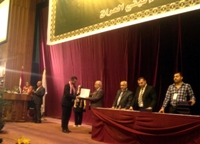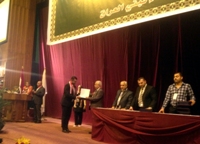|
على المستوى العلمي العالي وفي المجال التخصصي الدقيق تم نشر بحث قام به المدرس الدكتور ميران عبد الأمير عطية في إحدى المجلات العلمية الرصينة ذات معامل تأثير متميز قد تمت المشاركة بهذا البحث في جائزة يوم العلم الذي إقامته وزارة التعليم العالي والبحث العلمي دائرة البحث والتطوير وقد حصل الدكتور على جائزة يوم العلم وحصوله على المركز الأول على نطاق المجموعة الطبية في العراق
جهة اصدار المجلة تاريخ النشر No. Vol. IF عنوان المجلة (20%) عنوان البحث المنشور او المقبول للنشر 1 USA 2012 R199–R208 303 3.34 American Journal of Physiology – Regulatory, Integrative and Comparative Physiology Expression of sweet receptor components in equine small intestine: relevance to intestinal glucose transport نبذة عن البحث مع بيان مدى تطبيق البحث في مجالات الاختصاص ومدى الاستفادة منه 2 The heteromeric sweet taste receptor T1R2-T1R3 is expressed on the luminal membrane of certain populations of enteroendocrine cells. Sensing of sugars and other sweet compounds by this receptor activates a pathway in enteroendocrine cells, resulting in secretion of a number of gut hormones, including glucagon-like peptide 2 (GLP-2). This subsequently leads to upregulation in the expression of intestinal Na+/glucose cotransporter, SGLT1, and increased intestinal glucose absorption. On the basis of the current information available on the horse genome sequence, it has been proposed that the gene for T1R2 (Tas1R2) is absent in the horse. We show here, however, that horses express both the mRNA and protein for T1R2. Equine T1R2 is most closely homologous to that in the pig and the cow.T1R2 protein, along with T1R3, _-gustducin, and GLP-2 proteins are coexpressed in equine intestinal endocrine cells. Intravenous administration of GLP-2, in rats and pigs, leads to an increase in the expression of SGLT1 in absorptive enterocytes and enhancement in blood glucose concentrations. GLP-2 receptor is expressed in enteric neurons, excluding the direct effect of GLP-2 on enterocytes. However, electric stimulation of enteric neurons generates a neural response leading to SGLT1 upregulation, suggesting that sugar in the intestine activates a reflex increase in the functional expression of SGLT1. Horses possess the ability to upregulate SGLT1 expression in response to increased dietary carbohydrates, and to enhance the capacity of the gut to absorb glucose. The gut sweet receptor provides an accessible target for manipulating the equine gut to absorb glucose (and water), allowing greater energy uptake and hydration for hard-working horses. Perspectives and Significance The sweet sensor may provide a convenient and accessible target for manipulating the capacity of the equine intestine to absorb glucose (and water). This has potential for enhancing energy uptake and hydration for hard-working horses. Hard-working horses have a greater demand for glucose as a source of energy. Enhancing the activity of the intestinal glucose cotransporter 1, SGLT1, not only provides the horse with more glucose, but also salt and water. Equine intestine expresses the sweet-sensing components required for upregulation of SGLT1 in response to increased luminal glucose. The understanding of the functional properties of equine gastrointestinal carbohydrate sensing, digestion, and absorption allows the rational formulation of feed and feed supplements to enhance intestinal  glucoseand water absorption. This has attendant promise for enhancing equine performance and alleviating postexercise dehydration glucoseand water absorption. This has attendant promise for enhancing equine performance and alleviating postexercise dehydration
|


لا تعليق